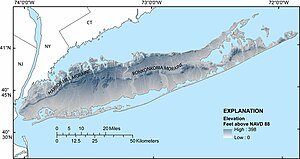Moraine
Jump to navigation
Jump to search

A moraine is an accumulation of a mixture of material moved by a glacier.[1]
Moraines consist of silt, clay, sand, gravel and rocks, all gathered from different locations the glacier crossed.[1] Different parts of a moraine may consist of different proportions of the basic ingredients.
Terminal moraines form at the greatest extent of a glacier, ploughed up like a snow-plow.[1]
Other moraines form when a glacier starts to melt, released silt, clay, sand, gravel and rocks that had been frozen within.[1] Melting water carries the released material to a lower point on the glaciers surface. And, once the glacier has fully melted away, there is a pile of glacially carried material.
References
- ↑ Jump up to: 1.0 1.1 1.2 1.3 (2006) Principles of sedimentology and stratigraphy, 4th. Upper Saddle River, N.J.: Pearson Prentice Hall. ISBN 0131547283.

